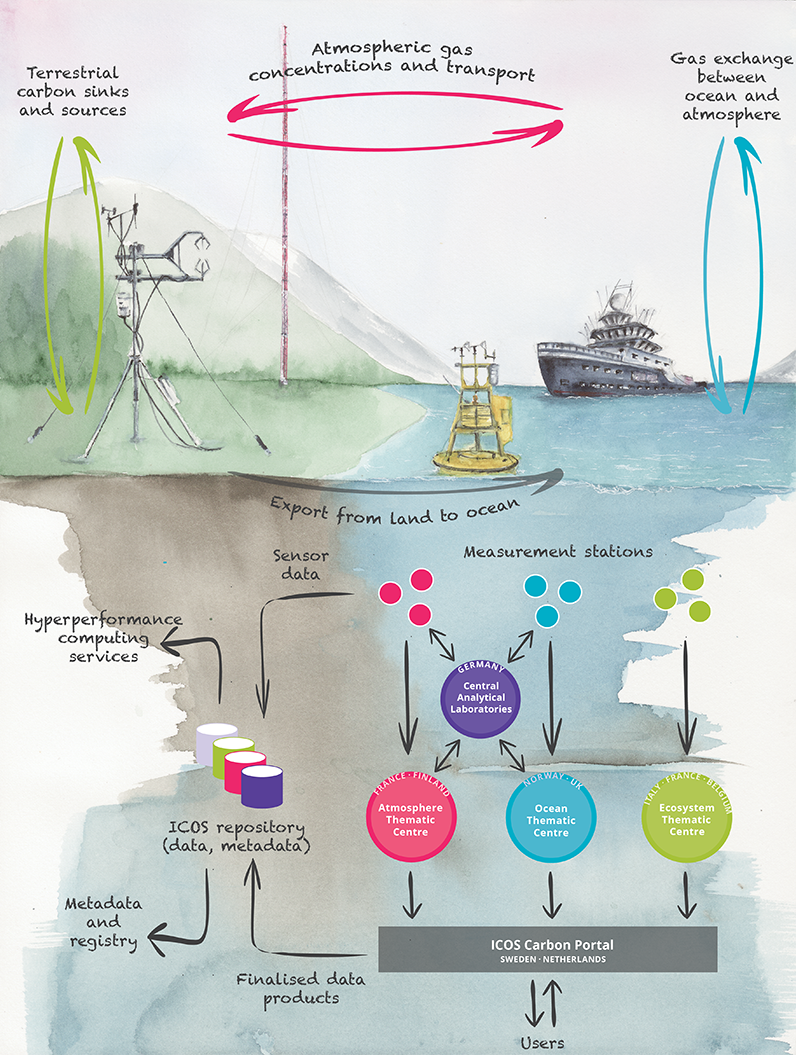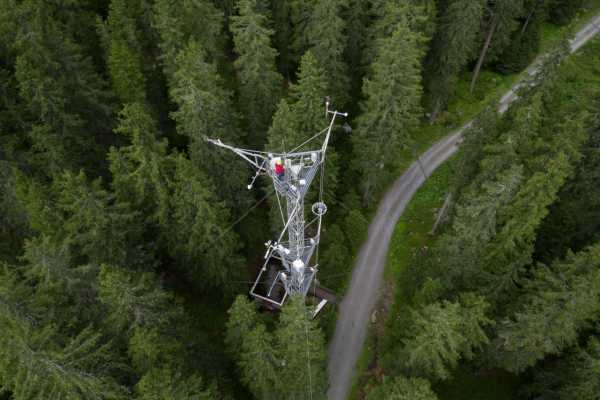Integrated Carbon Observation System Research Infrastructure (ICOS): First comprehensive article has been published
- D-USYS
- Institute of Agricultural Sciences
Half of the carbon emissions released to the atmosphere by fossil fuel use are re-captured by the ocean and land ecosystems. However, we still have many open questions. A recent article in The Bulletin of American Meteorological Society (BAMS) describes for the first time the structure and functioning of the Integrated Carbon Observation System (ICOS) Research Infrastructure.
What is the exact size, nature and stabilities of so-called ocean and land carbon sinks? How will they be affected by climate change? How do these sinks operate in detail, do they continue in the future? Answers to these questions are vital information for societies that must decide on pathways to climate neutrality.
"We have the tools to measure these greenhouse gas fluxes. Some of us measure them since decades. And only with such long-term, harmonised time series can we detect and understand the response of the biosphere to slow changes in climate”, says Nina Buchmann, Professor of Grassland Sciences at ETH Zurich and co-author of the article. “ICOS data are the basis to develop nature-based solutions. This ambitious goal makes ICOS so outstanding for science, highly relevant for decision-making, and beneficial for society.” Nina Buchmann is Head of external page ICOS Switzerland, and her team runs one of the ICOS Switzerland stations.
High quality greenhouse gas measurements throughout Europe
ICOS was designed as the European in situ observation and information system to support science and society in their efforts to mitigate climate change. It produces standardized and open data, currently from over 140 measurement stations across 13 European countries. Switzerland contributes with two stations to the network: Jungfraujoch and Davos, both of which are unique in terms of station history, location, and integration into national and international research programs.
The ICOS stations observe greenhouse gases in the atmosphere and carbon and greenhouse gas fluxes between the atmosphere, the land surface, and the oceans. The network covers the European continent from Scandinavia to the Spanish peninsula, and from the British islands to Hungary and Czech Republic. The adjacent oceans are covered by ship lines and research vessels operating on the area. Switzerland, with its exceptional geographic location in the central part of the Alps, is an outstanding node within the ICOS network.
Further, the article discusses the strict quality assurance and control methods developed within the ICOS community to ensure a very high data quality. Data are made open and free for all at the ICOS Carbon Portal.

More reliable results, faster
Thanks to the established processes leading to harmonised ICOS data in rapid pace, as well as the integration across research disciplines, the scientific community can identify existing gaps in knowledge, and bring forth topical research and results, in much faster pace than what the science world has seen before. The article mentions in particular the Drought 2018 Research Initiative, in which over 200 scientists worked together to study the effects of the exceptionally dry spring and summer of 2018, and produced 17 peer-reviewed articles in a high-profile journal (external page Special issue in Philosophical Transactions of the Royal Society B). Mana Gharun, postdoctoral researcher in the group of Nina Buchmann, led one of them. The team showed that the CO2 sink capacity of two Swiss forests were strongly reduced during the 2018 drought, with more severe effects at lower elevations than at higher elevations. Altogether, within the Drought 2018 Research Initiative these 17 articles were published in less than two years after the original measurements. This nicely illustrates the huge scientific progress, and the societal benefit of a well-connected scientific community, and of high-quality data being openly available within a few months after measurements.
Major scientific questions and a glimpse to the future
The article lifts a number of particularly important scientific questions in the field. Due to the growing urgency of climate change, many of these questions relate to policy frameworks such as the Paris Agreement or to the UN Sustainable Development goals. For example, ICOS is involved in providing important basic information to an envisaged EU monitoring and verification support system for greenhouse gas emissions. In this context, radiocarbon methodology is used in quantifying the emissions from fossil fuel burning, as carbon dioxide from fossil fuel sources is void of the radioactive carbon isotope, 14C.
Further research is needed on lateral carbon fluxes from land into oceans, which can currently only be quantified with large uncertainty. Indeed, while ICOS has taken some initial steps to build capacities to quantify also these fluxes, a lot remains to be done yet.
Further, the authors state that more accurate observations are needed in urban areas, since these densely populated areas are fossil fuel emission hotspots, and constantly growing. The success in emission reductions will be first visible there. ICOS is responding to this challenge by kicking off a new EU project “ICOS Cities – Pilot Applications in Urban Landscapes”. Two Swiss cities, Zurich and Basel, are part of the ICOS Cities project, with ICOS Switzerland partners from Empa and the University of Basel. An urban station in Basel will soon complement the Swiss stations within ICOS.
“With ICOS Cities, we aim to test different observation methods, by designing and building urban pilot observatories. We want to test and showcase different tools and services to process and analyse these observations, and do it all in a way that responds to the needs of the cities and supports them in realising their climate action plans,” tells Werner Kutsch, Director General of ICOS, and the coordinator of the project.
On a larger scale, the article mentions the compilation of a European carbon and greenhouse gas budget, which until now has only been possible with a considerable one-time effort. Soon, it could be produced annually, at high spatial resolution and with reduced uncertainty. This type of product would clearly benefit political actors to decide on the most feasible climate actions.
In conclusion, there are several urgently needed developments in the field of carbon science: how to detect climate change effects on the terrestrial and ocean sinks, how to best support the verification of national and local GHG inventories, and how to validate the efficacy of mitigation actions.
The ICOS article is published in external page The Bulletin of American Meteorological Society (BAMS).

ICOS Switzerland consists of ETH Zurich (National Focal Point), Empa, WSL, the University of Bern, the University of Basel, and MeteoSwiss. It has been funded by the Swiss National Science Foundation, in-house contributions, and the State Secretariat for Education, Research and Innovation since 2013 (Phase 1: 2013–2017; Phase 2: 2017–2021, Phase 3: 2021-2025).

